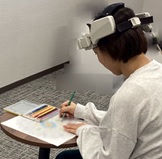World’s first*1 report: A potential effectiveness of Plasmacluster Technology that may induce brain activation
World’s first*1 report: A potential effectiveness of Plasmacluster Technology that may induce brain activation
Validation of the mechanism of its enhancing effect on human work performance
by measuring brain function *2
Sharp Corporation conducted collaborative research on its Plasmacluster technology, with Dr. Goichi Hagiwara, Associate Professor, Faculty of Human Sciences, Kyushu Sangyo University. When the mechanism of its enhancing effectiveness on human work performance is validated by measuring brain function, Sharp confirmed for the first time in the world, the potential to induce brain activation by exposing working people to Plasmacluster ions with positive and negative ions emitted simultaneously.
Through research using brain wave measurements, Sharp has demonstrated that its Plasmacluster technology contribute to the enhancing effectiveness on work performance (the reducing stress and maintaining the concentration of people working indoors or driving a car*3, 4 and the improvement of exercise training efficiency*5,6and esports scores*7 and so on), and this time, Sharp could approach specific mechanism for the first time.
From the results so far, Sharp considered the possibility of Plasmacluster technology effect not only on brain waves but also on blood flow (cerebral blood flow) in the prefrontal cortex, which is closely associated with concentration and cognition. Therefore, in this research, Sharp used a device to measure the changes in cerebral blood flow and then compared the changes under the following conditions: when subjects were not exposed to Plasmacluster ions (air flow only) and exposed to Plasmacluster ions.
As a result, the changes in cerebral blood flow that occurs during brain activation was confirmed when subjects were exposed to Plasmacluster ions, and it is suggested that this brain activation by the Plasmacluster technology contribute to the mechanism of the enhancing effectiveness on human work performance.
Plasmacluster technology is an air purification technology that uses the same positive and negative ions as those present in nature. A high level of safety and various effectiveness have been confirmed by conducting tests at independent third-party testing institutions in and outside Japan for more than 20 years. With the discovery of the potential of Plasmacluster technology to induce brain activation as a turning point, Sharp will continuously conduct the verification of the effectiveness and its mechanism against the human being to enhance its reliability, and will study the additional effectiveness and applicability of Plasmacluster technology to the new field.
Comments from Dr. Goichi Hagiwara, Associate Professor, Kyushu Sangyo University
Research on positive or negative ions only has been conducted till now, but there has been little progress in research emitting both simultaneously. In this research, the potential for brain activation to be induced by Plasmacluster technology with positive and negative ions emitted simultaneously was confirmed for the first time, and this is very significant for advancing research in this field. it is possible that work performance such as sports, learning, daily operations and so on is enhanced by improvement of the ability to think and take action due to this brain activation, so I look forward to further application of Plasmacluster technology in the future.
n Overview of Test to Investigate the Effects of Plasmacluster Ions on Cerebral Blood Flow
l Test conducted by: Dr. Goichi Hagiwara, Associate Professor (Kyushu Sangyo University)
l Test space: Laboratory in Kyushu Sangyo University (W 7.80 × D 3.40 × H 2.90 m)
l Subjects: 24 men and women; 19 to 22 years of age
l Verification test apparatus: Testing devices equipped with Plasmacluster technology、NIRS Brain Measuring Device
l Test conditions: a. Plasmacluster ions OFF (air flow only)
b. Plasmacluster ions ON (simultaneous exposure to positive and negative ions)
l Plasmacluster Ion density: Approx. 100,000 ions/cm3 at the positions of subjects
l Test method:
1. A NIRS Brain Measuring Device was fitted onto each subject.
2. The subjects colored picture under each test condition, and testing devices were halted after a predetermined period of time.
3. The changes in cerebral blood flow were checked and compared for the respective test conditions.


Fig. 1. Testing device layout image Fig. 2. Image of testing
l Results:
• Cerebral blood flow which the oxygenated hemoglobin concentration increased and deoxygenated hemoglobin concentration decreased was confirmed under the Plasmacluster ions ON condition. This suggested that brain activation may have occurred since the change is observed when brain activity occurs.
It is thought that this contributes to the mechanism of the enhancing effectiveness on human work performance by the Plasmacluster technology that has previously been verified.
※Oxy-Hb:Hemoglobin with bound oxygen、give oxygen to brain tissue
※Deoxy-Hb:Hemoglobin after delivering oxygen、back to lungs and receive oxygen
Research Institutes That Provided Data for Sharp’s Academic Marketing
|
Target |
Testing and Verification Organization |
|
Working mechanism of its enhancing effect on work performance |
Kyushu Sangyo University, Department of Sport Science and Health, Faculty of Human Sciences |
|
Working mechanism of inhibitory effects on viruses, fungi, and bacteria |
Professor Gerhard Artmann, Aachen University of Applied Sciences, Germany |
|
Working mechanism of inhibitory effects on allergens |
Graduate School of Advanced Sciences of Matter, Hiroshima University |
|
Working mechanism of skin moisturizing (water molecule coating) effect |
Research Institute of Electrical Communication, Tohoku University |
|
Efficacy proven in clinical trials |
Kyushu Sangyo University, Department of Sport Science and Health, Faculty of Human Sciences |
|
National Institute of Fitness and Sports in Kanoya |
|
|
Shibaura Institute of Technology, College of Systems Engineering and Science, Department of Machinery and Control Systems |
|
|
Littlesoftware Inc. |
|
|
Dentsu ScienceJam Inc. |
|
|
Graduate School of Medicine, University of Tokyo / Public Health Research Foundation |
|
|
Faculty of Science and Engineering, Chuo University / Clinical Research Support Center, University Hospital, University of Tokyo |
|
|
National Center of Tuberculosis and Lung Diseases, Georgia |
|
|
Animal Clinical Research Foundation |
|
|
Soiken Inc. |
|
|
School of Bioscience and Biotechnology, Tokyo University of Technology |
|
|
National Trust Co., Ltd. / HARG Treatment Center |
|
|
Evaluation of effects on cells |
Columbia University, Department of Medicine |
|
Viruses |
Kitasato Research Center of Environmental Sciences |
|
Seoul National University |
|
|
Shanghai Municipal Center for Disease Control and Prevention, China |
|
|
Kitasato Institute Medical Center Hospital |
|
|
Retroscreen Virology, Ltd., UK |
|
|
Shokukanken Inc. |
|
|
University of Indonesia |
|
|
Hanoi College of Technology, Vietnam National University, Vietnam |
|
|
Institut Pasteur, Ho Chi Minh City, Vietnam |
|
|
National Research Center for the Control and Prevention of Infectious Diseases, Institute of Tropical Medicine, Nagasaki University |
|
|
Department of Microbiology, Shimane University, Faculty of Medicine |
|
|
Columbia University, Department of Medicine |
|
|
Fungi |
Ishikawa Health Service Association |
|
University of Lübeck, Germany |
|
|
Professor Gerhard Artmann, Aachen University of Applied Sciences, Germany |
|
|
Japan Food Research Laboratories |
|
|
Shokukanken Inc. |
|
|
Shanghai Municipal Center for Disease Control and Prevention, China |
|
|
Biostir Inc. |
|
|
Medical Mycology Research Center, Chiba University |
|
|
Bacteria |
Ishikawa Health Service Association |
|
Shanghai Municipal Center for Disease Control and Prevention, China |
|
|
Kitasato Research Center of Environmental Sciences |
|
|
Kitasato Institute Medical Center Hospital |
|
|
Dr. Melvin W. First, Professor Emeritus, Harvard School of Public Health, US |
|
|
Animal Clinical Research Foundation |
|
|
University of Lübeck, Germany |
|
|
Professor Gerhard Artmann, Aachen University of Applied Sciences, Germany |
|
|
Japan Food Research Laboratories |
|
|
Shokukanken Inc. |
|
|
Chest Disease Institute, Thailand |
|
|
Biostir Inc. |
|
|
Allergens |
Graduate School of Advanced Sciences of Matter, Hiroshima University |
|
Department of Biochemistry and Molecular Pathology, Graduate School of Medicine, Osaka City University |
|
|
Safety |
LSI Medience Corporation |
|
Odors, pet smells |
Boken Quality Evaluation Institute |
|
Animal Clinical Research Foundation |
|
|
Skin beautifying effects |
School of Bioscience and Biotechnology, Tokyo University of Technology |
|
Hair beautifying effects |
Saticine Medical Co., Ltd. |
|
C.T.C Japan Ltd. |
|
|
Plant |
Facility of Agriculture, Shizuoka University |
|
Hazardous chemical substances |
Sumika Chemical Analysis Service Ltd. |
|
Indian Institutes of Technology Delhi |







